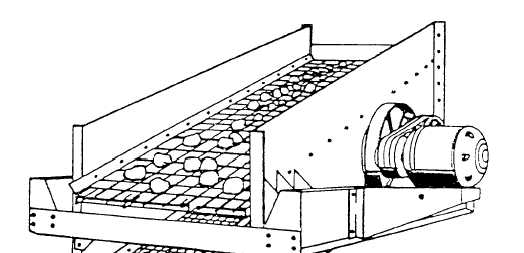setting may result in packing in the crusher
chamber, high loads and stresses, and possible
damage to major components.
After passing the dual roll crusher, the material is
recirculated to the top screen by means of a return
conveyer and a revolving elevator wheel. The material
from the hydrocone crusher is recirculated to the top
screen by means of a return conveyer and a crossover
chute. Any material still too large to pass the top screen
is routed through the roll crusher or hydrocone crusher
again. This is known as a “closed circuit” crushing
system. It is obvious that the product setting on the roll
crusher or hydrocone crusher should be set at or slightly
less than the opening size of the top screen.
The material retained on the bottom screen is the
product that is routed through a chute to a conveyer and
then delivered to the product stockpile. Material too
small to meet product specifications is screened out by
the bottom screen and delivered to a by-product
stockpile.
The secondary unit includes a bar type of scalping
screen that can be inserted into the top rim of the sloping
hopper. When inserted, this screen causes any oversized
material to be scalped and rolled off of the screen and
to the rear of the machine.
The same factors discussed for the jaw crusher also
affect the production of the roll crusher. By comparison,
dual roll crushers have a limited “stage of reduction”
capability. “Stage of reduction” is the difference,
expressed in inches or centimeters, between the
maximum input and maximum output size of material
due to a single crushing action. A stage of reduction of
3 inches (7.6 cm) indicates a 3-inch (7.6-cm) reduction
in maximum particle size. This reduction capability is a
function of the diameter of the rolls and of the nature of
the roll shell surface; therefore, every different size and
combination of roll shells has a somewhat different
stage of reduction capacity. For this reason the
maximum size of material to be fed to a dual roll crusher
is critical.
The maximum allowable feed size is the sum of the
stage of reduction capability and the product setting. If
the maximum feed size is exceeded, unsatisfactory
results likely to occur are as follows:
1. Retarded production
2. Excessive roll shell wear
3. Excessive long-and-flat particles
These units also have a wide range of production
capability. The actual rate of production in tons per hour
is usually determined by the screening capacity of the
screens. In some cases, the rate may be limited by the
capacity of the dual roll crusher or hydrocone crusher.
Screens
Crushed rock particles are separated into two or
more particle size ranges by the use of screens (fig. 6-9).
Screens are also used to scalp off oversized rock and to
Figure 6-9.-Vibrating screen box.
6-8



